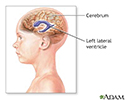Normal pressure hydrocephalus
Hydrocephalus - occult; Hydrocephalus - idiopathic; Hydrocephalus - adult; Hydrocephalus - communicating; Dementia - hydrocephalus; NPH
Hydrocephalus is a buildup of spinal fluid inside the fluid chambers of the brain. Hydrocephalus means "water on the brain."
Normal pressure hydrocephalus (NPH) is a rise in the amount of cerebrospinal fluid (CSF) in the brain that affects brain function. However, the pressure of the fluid is usually normal.
Causes
There is no known cause for NPH. But the chance of developing NPH is high in someone who previously had any of the following:
- Bleeding from a blood vessel or aneurysm in the brain (subarachnoid hemorrhage)
- Certain head injuries
- Meningitis or similar infections
- Surgery on the brain (craniotomy)
As CSF builds up in the brain, the fluid-filled chambers (ventricles) of the brain swell. This causes pressure on brain tissue. This can damage or destroy parts of the brain.
Symptoms
Symptoms of NPH often begin slowly. There are three main symptoms of NPH:
- Changes in the way a person walks: difficulty when beginning to walk (gait apraxia), feeling as if your feet are stuck to the ground (magnetic gait)
- Slowing of mental function: forgetfulness, difficulty paying attention, apathy or no mood
- Problems controlling urine (urinary incontinence), and sometimes controlling stools (bowel incontinence)
Diagnosis of NPH can be made if any of the above symptoms occur and NPH is suspected and testing is done.
Exams and Tests
Your health care provider will perform a physical examination and ask about the symptoms. If you have NPH, your provider will likely find that your walking (gait) is not normal. You may also have memory problems.
Tests that may be done include:
- Head CT scan or MRI of the head
- Lumbar puncture (spinal tap) with careful testing of walking before and right after the spinal tap
Treatment
Treatment for NPH usually requires surgery to place a tube called a shunt that routes the excess CSF out of the brain ventricles and into the abdomen. This is called a ventriculoperitoneal shunt.
Outlook (Prognosis)
Without treatment, symptoms often get worse and could lead to death.
Surgery improves symptoms in some people. Those with mild symptoms have the best outcome. Walking is the symptom most likely to improve.
Possible Complications
Problems that may result from NPH or its treatment include:
- Complications of surgery (infection, bleeding, shunt that does not work well)
- Loss of brain function (dementia) that becomes worse over time
- Injury from falls
- Shortened life span
When to Contact a Medical Professional
Contact your provider if:
- You or a loved one is having increasing problems with memory, walking, or urine incontinence.
- A person with NPH worsens to the point where you are unable to care for the person yourself.
Go to the emergency room or call 911 or the local emergency number if a sudden change in mental status occurs. This may mean that another disorder has developed.
References
Frim DM, Vivas-Buitrago T, Rigamonti D, Lacy M. Surgical management of hydrocephalus in the adult. In: Quiñones-Hinojosa A, ed. Schmidek and Sweet: Operative Neurosurgical Techniques. 7th ed. Philadelphia, PA: Elsevier; 2022:chap 81.
Rosenberg GA. Brain edema and disorders of cerebrospinal fluid circulation. In: Jankovic J, Mazziotta JC, Pomeroy SL, Newman NJ, eds. Bradley and Daroff's Neurology in Clinical Practice. 8th ed. Philadelphia, PA: Elsevier; 2022:chap 88.
Sivakumar W, Drake JM, Riva-Cambrin J. The role of endoscopic third ventriculostomy: a critical review. In: Winn HR, ed. Youmans and Winn Neurological Surgery. 8th ed. Philadelphia, PA: Elsevier; 2023:chap 45.
Review Date: 3/31/2024
Reviewed By: Joseph V. Campellone, MD, Department of Neurology, Cooper Medical School at Rowan University, Camden, NJ. Review provided by VeriMed Healthcare Network. Also reviewed by David C. Dugdale, MD, Medical Director, Brenda Conaway, Editorial Director, and the A.D.A.M. Editorial team.












